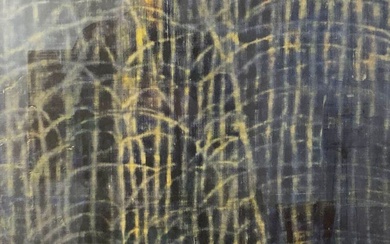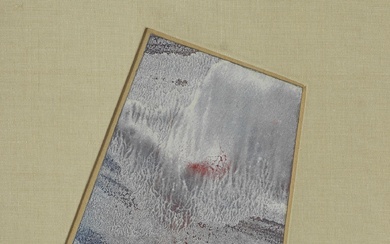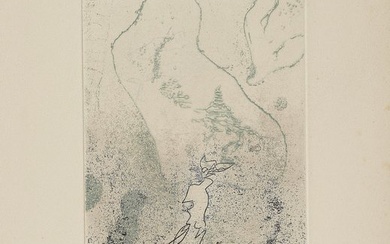MAX ERNST, (1891-1976)
De la terre à la lune
De la terre à la lune
signed and dated 'Max Ernst 66' (lower right) and inscribed 'De la terre à la lune' (lower left)
collage on paper
78.7 x 57.1cm (31 x 22 1/2in).
Executed in 1966
Provenance
Max Ernst Collection.
Dorothea Tanning Collection, US (by descent from the above).
Thence by descent to the present owner.
Exhibited
Vence, Galerie Alphonse Chave, Max Ernst, Peintures, Collages, récents, 13 September – 15 November 1966, no. 16 (illustrated).
Literature
W. Spies, S. & G. Metken & J. Pech, Max Ernst Œuvre-Katalog, Vol. VII, Werke 1964-1969, Cologne, 2007, no. 4190 (illustrated p. 175).
This collection tells the story of Max Ernst and Dorothea Tanning. The two met each other for the first time at one of Julien Levy's 'dazzling' gatherings on an afternoon in May of 1942. However, Ernst would not enter Tanning's world permanently until he visited her studio later that year. He came to select an artwork for Peggy Guggenheim's upcoming exhibition which was called 31 Women. After a game of chess, another one followed, and another one, until a week had gone by and Ernst moved in: 'There was no discussion. It was as if he had found a house. Yes, I think I was his house. He lived in me, he decorated me, he watched over me' (D. Tanning, Between Lives, An Artist and Her World, New York, 2001, p. 64).
Before then, Tanning first encountered Surrealism in 1936 at the ground-breaking exhibition Fantastic Art, Dada and Surrealism at the MoMA. It had a profound impact on her as she later recalled that she could 'go ahead and do what I've always been doing' (Dorothea Tanning quoted in The Guardian, 15 August 2004, online article). This event led her to undertake a crusade to Paris in 1939. However, soon thereafter, the outbreak of the war in Europe would bring Surrealism to New York, and with that came Max Ernst as one of the émigré artists who fled to America in the early 1940s.
The couple married in 1946 in a double ceremony with Man Ray and Julie Browner, and embarked on adventures together until Ernst's death in 1976. Ernst propelled Tanning into the world of the Surrealism, although 'they never talked art' when they were together. In fact, as a couple they were sometimes larger than life. Looking back, Tanning wrote in her memoir: 'And even though it may be in the middle of the night we lean, Max and I, over our shared past, so recent, so green, and, yes, so simply a prologue; peering with a kind of careful wonder at our first days, first events, first people, our brash leaps, miraculous escapes. We examine the long chain and all its details like the wonderful spine of some perfectly meshed skeleton, an extinct species never to be seen again' (Dorothea Tanning quoted in op. cit, p. 57).
Each work from the present collection represents a different time in their life together. Comète was painted during the couple's last years in Arizona, before they returned to France, whilst the sculptures from the early 60s, Apaisement and Tourangelle (the latter originally conceived as a trophy for the Film Festival in Tours), strongly resonate with Ernst's interest in totemic sculpture and non-European art which he discovered upon his arrival in the US. After Ernst's death Tanning returned to New York, and always kept La Tourangelle in her apartment. In the 1960s Ernst took up collage again. Seillans, where the couple had a summer dwelling, remained a gathering place for many of the old émigré circle such as Marcel and Teeny Duchamp. Here Ernst executed L'Œil du peintre and De la terre à la lune, which were created for a solo exhibition at the gallery of Alphonse and Pierre Chave, who were good friends of the couple. They organised several shows of Ernst's work during the summer of 1966. The present works have remained in Dorothea Tanning's personal collection since Ernst's death. They have never been seen on the market, and most of them have not been exhibited to the public for decades.
View it on
Estimate
Time, Location
Auction House
De la terre à la lune
De la terre à la lune
signed and dated 'Max Ernst 66' (lower right) and inscribed 'De la terre à la lune' (lower left)
collage on paper
78.7 x 57.1cm (31 x 22 1/2in).
Executed in 1966
Provenance
Max Ernst Collection.
Dorothea Tanning Collection, US (by descent from the above).
Thence by descent to the present owner.
Exhibited
Vence, Galerie Alphonse Chave, Max Ernst, Peintures, Collages, récents, 13 September – 15 November 1966, no. 16 (illustrated).
Literature
W. Spies, S. & G. Metken & J. Pech, Max Ernst Œuvre-Katalog, Vol. VII, Werke 1964-1969, Cologne, 2007, no. 4190 (illustrated p. 175).
This collection tells the story of Max Ernst and Dorothea Tanning. The two met each other for the first time at one of Julien Levy's 'dazzling' gatherings on an afternoon in May of 1942. However, Ernst would not enter Tanning's world permanently until he visited her studio later that year. He came to select an artwork for Peggy Guggenheim's upcoming exhibition which was called 31 Women. After a game of chess, another one followed, and another one, until a week had gone by and Ernst moved in: 'There was no discussion. It was as if he had found a house. Yes, I think I was his house. He lived in me, he decorated me, he watched over me' (D. Tanning, Between Lives, An Artist and Her World, New York, 2001, p. 64).
Before then, Tanning first encountered Surrealism in 1936 at the ground-breaking exhibition Fantastic Art, Dada and Surrealism at the MoMA. It had a profound impact on her as she later recalled that she could 'go ahead and do what I've always been doing' (Dorothea Tanning quoted in The Guardian, 15 August 2004, online article). This event led her to undertake a crusade to Paris in 1939. However, soon thereafter, the outbreak of the war in Europe would bring Surrealism to New York, and with that came Max Ernst as one of the émigré artists who fled to America in the early 1940s.
The couple married in 1946 in a double ceremony with Man Ray and Julie Browner, and embarked on adventures together until Ernst's death in 1976. Ernst propelled Tanning into the world of the Surrealism, although 'they never talked art' when they were together. In fact, as a couple they were sometimes larger than life. Looking back, Tanning wrote in her memoir: 'And even though it may be in the middle of the night we lean, Max and I, over our shared past, so recent, so green, and, yes, so simply a prologue; peering with a kind of careful wonder at our first days, first events, first people, our brash leaps, miraculous escapes. We examine the long chain and all its details like the wonderful spine of some perfectly meshed skeleton, an extinct species never to be seen again' (Dorothea Tanning quoted in op. cit, p. 57).
Each work from the present collection represents a different time in their life together. Comète was painted during the couple's last years in Arizona, before they returned to France, whilst the sculptures from the early 60s, Apaisement and Tourangelle (the latter originally conceived as a trophy for the Film Festival in Tours), strongly resonate with Ernst's interest in totemic sculpture and non-European art which he discovered upon his arrival in the US. After Ernst's death Tanning returned to New York, and always kept La Tourangelle in her apartment. In the 1960s Ernst took up collage again. Seillans, where the couple had a summer dwelling, remained a gathering place for many of the old émigré circle such as Marcel and Teeny Duchamp. Here Ernst executed L'Œil du peintre and De la terre à la lune, which were created for a solo exhibition at the gallery of Alphonse and Pierre Chave, who were good friends of the couple. They organised several shows of Ernst's work during the summer of 1966. The present works have remained in Dorothea Tanning's personal collection since Ernst's death. They have never been seen on the market, and most of them have not been exhibited to the public for decades.







